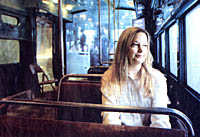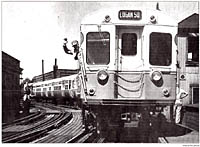Next stop: History
U. of C. grad navigates 'L' car into the
Smithsonian
By Michael Kilian
Washington Bureau
Date of Publication: January 6, 2004
Source: Chicago
Tribune
WASHINGTON -- A year ago, Chicago Transit Authority elevated
train car No. 6719 was a nearly half-century-old relic sitting on the
scrap line at the CTA's Skokie yards awaiting reduction to a $1,200
pile of junk metal.
Instead, it now sits in a place of honor at the Smithsonian
Institution as a symbol of an important part of American history --
one of the centerpieces of a huge new permanent exhibition hall. How
this came about can be explained in just two words.

"Some of the people looked
at me as though I was a little bit nuts," she the
Smithsonian's Bonnie Lilienfeld, shown inside the museum's
"L" car. "But I'd done so much research -- I have this
tendency to overwhelm people with information -- so I
overwhelmed them with information about CTA history and how
important this was and how central Chicago was during the
1950s." For a larger view, click here.
(Tribune photo by Pete Souza)
|
"Bonnie Lilienfeld," said Brent Glass, director of the Smithsonian's
National Museum of American History, where the new "America on the
Move" transportation hall is located.
As the world's largest museum and research complex, the
Smithsonian can draw upon myriad sophisticated resources. What
counted for most in this regard, though, is that it has on its
curatorial staff a University of Chicago graduate who is absolutely
nuts about Chicago's "L."
"I love Chicago," said Lilienfeld, who lived in the city from 1978
to 1987. "I love the 'L.' I loved taking the Howard line [from
Hyde Park] because it was elevated and ran through the South
Side. It's changing now, but it was this really urban landscape.
Coming from a small town in western New York as I did, to me it was
just like magic being on the train with the noises and just watching
the people."
In fact, she used to ride the "L" as a principal form of
recreation.
"I did. I'd just ride downtown and, go around the Loop, get off
and walk around and look at the buildings. I didn't even have a
driver's license."
The new $22 million, 26,000 square foot exhibition hall embraces
the history of American transportation from post-Civil War Western
narrow gauge railroads to New York harbor in the glory days of
steamships to the modern freeway, complete with a monumental traffic
jam.
But a very large section of it is devoted to Chicago and the
enormous role transit played in maintaining the city's vitality and
viability in the post-World War II era that saw the flight of
hundreds of thousands of people to the suburbs.
The sprawling display includes not only "L" car No. 6719 but a
facsimile of the Wabash and Madison station and platform, the front
section of a 1950s vintage CTA bus and a representation of a suburban
Park Forest house and an actual 1955 Ford Country Squire station
wagon.
A lifelike, life-size polyurethane figure behind the wheel of the
bus tells, by means of a recording, the actual story of a now retired
CTA bus driver.
But a much more amazing verisimilitude is achieved within the "L"
car, where visitors will be able to experience a ride around the
Loop. The car rumbles and seems to sway, wheels screech, lights
flicker and the shadows of buildings darken the foggy windows.
At the rear of the car, a computerized screen projection shows
videotaped 1959 vintage passengers (played by actors) getting on and
off the train at various stops, talking about things of import in
1959, reading vintage newspapers and carrying vintage Marshall Field
shopping bags.
"Bonnie did a terrific job," said Glass. "I have to believe this
is going to be the hit of the show."
When the museum embarked on the new transportation hall project
four years ago, it made detailed plans for many aspects of the
exhibition, but had nothing in mind for Chicago except the notion
that something about it ought to be included.
Lilienfeld, then as now the museum's curator of ceramics and
glass, rushed to fill the void.
"I saw this big diagram of the exhibition, and it just had a big
circle in the middle labeled 'Chicago,'" she said. "So I went to
[project director Steve] Lubar, who's another University of
Chicago person, and said, 'I'd love to work on this. I know a lot
about Chicago history. I have a big library of Chicago books, and I'm
really interested in Chicago transit."
They agreed -- and then some.
"I would sometimes ask for guidance, so I wouldn't have to be
fully responsible for everything," she said, "and he'd say, 'No, this
is your project; you take care of it.'"
She considered the 1920s and 1940s, but finally settled on the
1950s -- a time when Chicago was undergoing a tremendous
resurgence.
Decade of change
"The '50s were a really dynamic period in Chicago," she said. "You
had Mayor [Richard J.] Daley coming in, which was a huge
deal. You had urban renewal, for good and bad. You had a lot of
demographic and social changes going on in the city and suburbs. They
were building the expressways. In the 1950s, Chicago pioneered the
use of expressway medians for rapid transit trains."
She found the 1950s vintage bus in a junkyard 45 miles outside of
Omaha, Neb., and tracked down a driver from that time who was retired
in Florida.
"I was looking for an African-American bus driver because I wanted
to talk about transit as an opportunity for work for
African-Americans at a time when there weren't a lot of other
opportunities."
She had hoped to get actual pieces of the Wabash and Madison
station but that proved impossible. "We're using that old station as
an office," said CTA planning manager and historian Bruce Moffat.
Dream comes true
Her dream of acquiring an actual 1950s "L" car came true only in
the nick of time.
"There were only two cars from that series left," said CTA Vice
President for Planning and Development Michael Shiffer, who used to
ride the 'L' as a boy growing up in Rogers Park. "We sold it to
Bonnie for the scrap price -- $1,200 -- though I think it cost more
than that to ship it to Washington."
He said it contained a double load of history because some of the
720 "L" cars in that series were made from recycled metal and parts
of Chicago's old "Green Hornet" streamlined streetcars that were
discontinued in the 1950s.
Shiffer, previously a professor of urban planning at the
University of Illinois and M.I.T., said Lilienfeld was correct to
pick the 1950s as an important period.
Impact on downtown

A 1950s Chicago "L" car,
similar to those on this train, has a place of honor in the
new $22 million exhibition hall at the Smithsonian
Institution. For a larger view, click here.
(Tribune file photo)
|
"Rapid transit had a significant impact in making downtown Chicago
what it is today despite the trend to the suburbs," he said. "A
single elevated train can carry a thousand passengers. When you think
of one coming along every few minutes, that's a lot of people being
brought into the area."
Some at the Smithsonian were opposed to bringing the "L" car into
the exhibition because it is 48 feet long. There was talk of cutting
it in half, an act Lilienfeld viewed as akin to homicide.
"Some of the people looked at me as though I was a little bit
nuts," she said, "but I'd done so much research -- I have this
tendency to overwhelm people with information -- so I overwhelmed
them with information about CTA history and how important this was
and how central Chicago was during the 1950s. I wore them down
[about the car] and then I wore them down about cutting the
car in half."
She did have to agree to removing the car's wheels to accommodate
the level of the replicated platform.
The car has now been installed, repainted its original Colorado
green, cream and orange, and decorated with authentic period decals
from the Illinois Railway Museum in McHenry County.
"She presented us with some real research challenges," said
Moffat, "such as, what color were the original window sills?"
"Bonnie is one of my favorite people," said Shiffer. "She has
tremendous enthusiasm. She's very good at really [being] able
to get what she needs. Museums are very fortunate to have people like
her."
New York state native
The daughter of an Episcopal priest, Lilienfeld, 43, grew up in
Jamestown, N.Y. -- also home, she proudly notes, to Lucille Ball and
the rock band 10,000 Maniacs.
She went to U. of C. to become an Egyptologist, switched to urban
history, and then to English, and finally graduated with a degree in
music history.
"I call myself eclectic to avoid being called scatterbrained," she
said.
She then got an administrative job in the U. of C. Hospital's
gastrointestinal clinic, and thought of seeking a doctorate in
American history.
"But what I mostly did was ride around Chicago on the 'L,'" she
said.
Then married, she moved to Washington when her husband got a
government job. She phoned the Smithsonian to inquire about
employment and told them she had gone to U. of C. "'I got my master's
and PhD there,'" said the curator she talked to. "'You must be
OK.'"
The "L" cars of that vintage came in what are called "married
pairs," and Lilienfeld yearned to buy No. 6719's mate -- No. 6720.
The price was right, but she had no place to put it and the car is
now scrap.
But she's found consolation.
"I moved into a condo that's about 25 feet away from the end of
the [Washington Metro transit system's] Yellow Line, so I
could be near the trains," she said. "I hear them at night."
Copyright © 2004, Chicago Tribune

